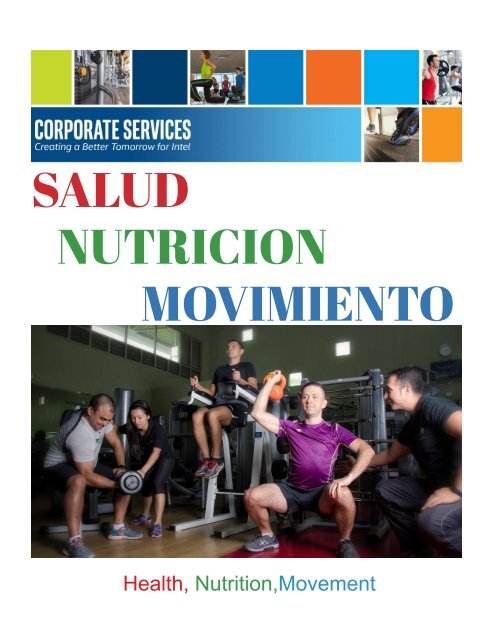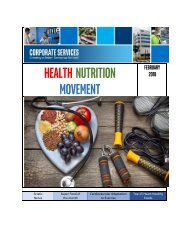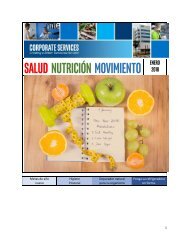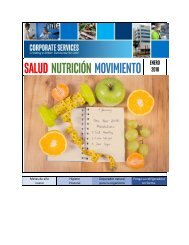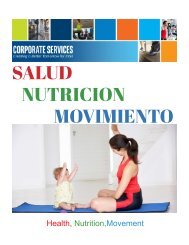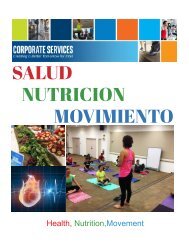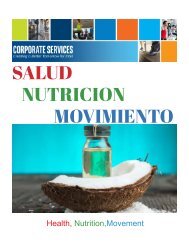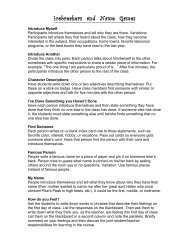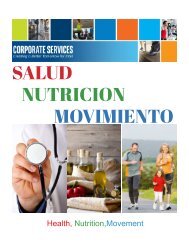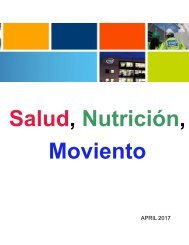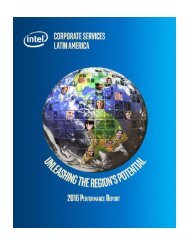You also want an ePaper? Increase the reach of your titles
YUMPU automatically turns print PDFs into web optimized ePapers that Google loves.
SALUD<br />
NUTRICION<br />
MOVIMIENTO<br />
Health, Nutrition,Movement
CONTENIDO (content)<br />
Cancer de Próstata mitos y realidades .......................<br />
Prostate Cancer: myths and facts<br />
Antioxidantes: nutrientes que previenen el cáncer de<br />
próstata .......................................................................<br />
Antioxidants: the nutrients that prevent prostate cancer<br />
Super Alimento del Mes: La Almendra un regalo para<br />
la salud .................................................................................................................<br />
Super food of the month: Almonds a gift for your health.<br />
LA RECETA DEL MES: Queque caramelizado con<br />
almendras ....................................................................<br />
Recipe of the month: Caramelized cake with almonds<br />
Papás todo terreno ...............................................<br />
Dads, all wheel-drive<br />
Beneficios de pasar tiempo de calidad en familia<br />
“Consejos para Papá en su día” ................................<br />
2<br />
5<br />
6<br />
8<br />
10<br />
16<br />
Benefits of spending quality time with family "tips for Dad on his day”<br />
Awake@Intel llega a Costa Rica ...............................<br />
Awake@Intel is coming to Costa Rica.<br />
Actividades y eventos del mes ..................................<br />
Events of the month<br />
18<br />
19<br />
1
Cáncer de Próstata<br />
Mitos y realidades<br />
Prostate cancer<br />
Myths and facts<br />
El cáncer de próstata es uno de los tumores<br />
malignos más frecuentes en el hombre; su<br />
frecuencia aumenta con la edad, no es un secreto<br />
que detrás del proceso diagnostico existe un<br />
rechazo, multifactorial, por parte de los pacientes,<br />
sin embargo el hallazgo temprano de una lesión<br />
maligna mejora el pronóstico y supervivencia de<br />
los pacientes.<br />
Prostate cancer is one of the most frequent<br />
male malignant tumors; its frequency<br />
increases with age, it is not a secret that<br />
behind the diagnosis process there is a<br />
multifactorial rejection by patients, however<br />
the early discovery of a malignant lesion<br />
improves the prognosis and survival of<br />
patients.<br />
Factores de riesgo<br />
1. La edad: Entre los factores de riesgo más<br />
importantes está la edad, pues principalmente<br />
aparece después de los 50 años.<br />
2. La raza: Estudios realizados en E.E. U.U.<br />
demostraron que es más frecuente en los<br />
afroamericanos que en los blancos, y menos<br />
frecuente en los indios americanos y en los<br />
asiáticos.<br />
3. Historia familiar de cáncer de la próstata: Si<br />
el paciente tiene antecedentes en el padre o en<br />
un hermano de haberlo padecido, tiene mucho<br />
más riesgo que el resto de la población.<br />
Risk factors<br />
1. Age: among the most important risk<br />
factors is age, as it mainly appears after age<br />
50.<br />
2. Race: E.E. U.U. studies showed that it<br />
is<br />
more common in African-Americans than in<br />
whites, and less frequent in Native American<br />
and Asians.<br />
3. Family history of prostate cancer:<br />
If the patient has a history of father or a<br />
brother suffering the disease, he has much<br />
more risk than the rest of the population.<br />
2
4. Dieta: Existen evidencias que sugieren que una<br />
dieta rica en grasa animal incrementa el riesgo, y<br />
lo contrario ocurre con una dieta rica en vegetales<br />
y frutas; incluso como veremos más adelante<br />
existen evidencias que ciertos suplementos<br />
dietéticos pueden prevenir su aparición<br />
5. Otros: Se realizan aún estudios para definir si<br />
factores como la vasectomía, la hiperplasia<br />
protática benigna, la obesidad, el sedentarismo, el<br />
tabaquismo, la exposición a radiaciones, la<br />
industria del caucho, los altos niveles de<br />
testosterona, la exposición al cadmio o los virus<br />
de transmisión sexual puedan tener alguna<br />
importancia en la génesis de dicha enfermedad.<br />
Sintomatología<br />
Es un tumor, por lo general de crecimiento lento, y<br />
que muchas veces pasa indolente para el paciente<br />
¿Cómo realizar el diagnóstico?<br />
1. Examen físico general: Está destinado a<br />
detectar repercusión del tumor en el resto del<br />
organismo. Se debe hacer hincapié en la<br />
columna lumbo sacra, la pelvis, el hígado y el<br />
pulmón<br />
2. Tacto rectal: Con una sensibilidad del 70 % y<br />
una especificidad del 90 % es de suma<br />
importancia para valorar tamaño, consistencia,<br />
movilidad, delimitación y regularidad de la<br />
glándula. Tiene un 50 % de probabilidad de<br />
falsos positivos, pero es lo idóneo para el<br />
diagnóstico precoz.<br />
3. Antígeno prostático específico (PSA):<br />
Con una sensibilidad mayor del 80 % y una<br />
especificidad del 98 %, no se altera con el tacto<br />
rectal como se pensaba hasta hace unos años,<br />
y es de suma importancia. Su valor normal<br />
oscila entre 0 y 5 ng/ml.<br />
4. Diet: There is evidence to suggest that a<br />
diet high in animal fat increases the risk,<br />
and the opposite occurs with a diet rich in<br />
fruits and vegetables; even as we will see<br />
later there is evidence that certain dietary<br />
supplements can prevent its onset.<br />
5. Others: There are still studies to define if<br />
factors such as vasectomy, benign<br />
prostatic hyperplasia, obesity, sedentary<br />
lifestyle, smoking, exposure to radiation,<br />
the rubber industry, high levels of<br />
testosterone, exposure to cadmium or<br />
sexually transmitted viruses may have<br />
some importance in the genesis of the<br />
disease.<br />
Symptomatology<br />
It is a tumor, usually of slow growth, and that<br />
often happens indolent for the patient<br />
How to make the diagnosis?<br />
1. General physical examination: Is<br />
intended to detect impact of tumor<br />
elsewhere in the body. Should be<br />
emphasizing the lumbar sacral spine,<br />
pelvis, liver, and lung<br />
2. Rectal examination: With a sensitivity of<br />
70% and a specificity of 90% is of utmost<br />
importance to assess the size, consistency,<br />
mobility, delimitation and regularity of the<br />
gland. It has a 50% probability of false<br />
positives, but it is suitable for early<br />
diagnosis.<br />
3. Prostatic specific antigen (PSA): With<br />
one sensitivity of 80% and a specificity of<br />
98%, is not altered by the rectal tact as<br />
previously thought until a few years ago,<br />
and is of utmost importance. Normal<br />
value ranges between 0 and 5 ng/ml.<br />
3
4. Biopsia de la próstata: Puede ser con aguja<br />
fina, perioperatoria o pos operatoria. Se puede<br />
realizar con ultrasonido o dirigida por el tacto<br />
4. Prostate Biopsy: Can be with a thin<br />
needle, pre or post-surgery. Can be done<br />
with ultrasound or rectum exploration.<br />
Conclusiones<br />
El cáncer de la próstata es un tumor frecuente<br />
que cobra la vida de miles de hombres en el<br />
mundo todos los años. Aunque exista estudios<br />
que afirmen que el ultrasonido y PSA sean<br />
parte del método diagnóstico, el tacto rectal<br />
continua siendo el primer procedimiento que<br />
se recomienda, por su alta sensibilidad y<br />
especificidad, además de bajo costo.<br />
Conclusions<br />
Prostate cancer is a common tumor that<br />
takes the lives of thousands of men in the<br />
world every year. Although there are studies<br />
claiming that the ultrasound and PSA are<br />
part of the diagnostic method, rectal<br />
exploration continue to be the primary<br />
procedure that is recommended through its<br />
high sensitivity and specificity, as well as the<br />
low-cost.<br />
Desarrollado: Dr. Josue<br />
Cordero Solano<br />
Referencia:<br />
Revista Cubana de Medicina General Integral,<br />
Versión On-line ISSN 1561-3038 Rev Cubana<br />
Med Gen Integr v.18 n.5 Ciudad de La Habana<br />
sep.-oct. 2002<br />
4
Antioxidantes: nutrientes que<br />
previenen el cáncer de próstata<br />
No existe una forma segura de prevenir el cáncer de<br />
próstata. A menudo los resultados de los estudios son<br />
contradictorios y la mayoría no está diseñada para<br />
probar de forma definitiva si algo ayuda a prevenir el<br />
cáncer de próstata. Sin embargo mantener una buena<br />
salud y una buena alimentación puede reducir el riego de<br />
padecerlo.<br />
1. Elija una dieta baja en grasas: Modere el consumo<br />
de grasas: incluye carnes, nueces, semillas, aceites y<br />
productos lácteos, como la leche, el yogurt y el queso.<br />
Estudios, muestran que los hombres que consumen<br />
mayores cantidades de grasa tiene una mayor probabilidad<br />
de padecer cáncer de próstata. Una dieta baja en grasa<br />
ayuda a mantener un peso saludable y una mejor salud<br />
cardiovascular.<br />
2. Prefiera las grasas vegetales:<br />
Las grasas de origen animal aumentan el riesgo de cáncer<br />
de próstata. Entre ellas la manteca, la mantequilla y carnes<br />
de origen animal.<br />
3. Incremente la cantidad de frutas y vegetales:<br />
Éstas son fuente de vitaminas y minerales, nutrientes los<br />
cuales previenen el riesgo de cáncer de próstata debido a su<br />
alto contenido de antioxidantes. Éstos disminuyen la<br />
producción de radicales libres o toxinas en nuestro<br />
organismo.<br />
4. Aumente el consumo de pescado:<br />
Los pescados grasos como el salmón, el atún y el arenque<br />
contienen ácidos grasos omega-3, un tipo de ácido graso<br />
esencial vinculado con la reducción del riesgo de cáncer de<br />
próstata. También puedes encontrarlo en la linaza.<br />
5. Reduzca la cantidad de productos lácteos:<br />
Estudios muestran que los lácteos como la leche, el queso y<br />
yogur en altas cantidades pueden aumentar el riesgo de<br />
padecer cáncer de próstata. Debido a éstos debes<br />
consumirlo en cantidades moderadas.<br />
Antioxidants: the nutrients<br />
that prevent prostate cancer<br />
There is no sure way to prevent prostate cancer. The<br />
results of the studies are often contradictory and<br />
most are not designed to definitively prove if<br />
something helps prevent prostate cancer. However<br />
to maintain good health and good nutrition can<br />
reduce the risk of developing.<br />
1. Choose a diet low in fat:<br />
Moderate fat intake: includes meats, nuts, seeds,<br />
oils and dairy products, like milk, yogurt and<br />
cheese. Studies show that men who consume<br />
higher amounts of fat has a greater chance of<br />
developing prostate cancer. A low-fat diet helps to<br />
maintain a healthy weight and a better<br />
cardiovascular health.<br />
2. Prefer the vegetable fats:<br />
The animal fat increases the risk of prostate cancer.<br />
Including butter and animal meat.<br />
3. Increase the amount of fruits and vegetables:<br />
These are source of vitamins and minerals, nutrients<br />
which prevent the risk of prostate cancer due to its<br />
high content of antioxidants. These decreases free<br />
radical production or toxins in our body.<br />
4. Increase fish consumption:<br />
Fatty such as salmon, tuna and Herring fish contain<br />
fatty acids omega-3, a type of essential fatty acid<br />
linked to reducing the risk of prostate cancer. You<br />
can also find it in flaxseed.<br />
5. Reduce the amount of dairy products:<br />
Studies have shown that your dairy such as milk,<br />
cheese and yogurt in high amounts can increase the<br />
risk of prostate cancer. Due to this you should<br />
consume it in moderate amounts.<br />
Remember to maintain good health, it is important<br />
to have a good diet and supplement it with physical<br />
activity.<br />
5
Super Alimento del Mes<br />
La Almendra un regalo para la salud<br />
A pesar de su alto contenido graso, las almendras son<br />
reconocidas como uno de los frutos secos más nutritivos, y<br />
además de tener un delicioso sabor son muy beneficiosas<br />
para la salud, ya que ayudan a prevenir muchas<br />
enfermedades.<br />
Las almendras ayudan a fortalecer los huesos, permiten que<br />
la piel y el cabello se vean saludables e hidratados.<br />
1. Poseen una masiva dosis de nutrientes<br />
La almendra es la semilla comestible del árbol Prunus<br />
dulcis, comunmente conocido como almendro.<br />
Incluyen un perfil nutricional muy atractivo. Un puñado<br />
pequeño de alrededor de 28 gramos contiene:<br />
Fibra: 3.5 gramos.<br />
Proteínas: 6 gramos.<br />
Grasas: 14 gramos (9 de los cuales son grasas<br />
monoinsaturadas).<br />
Vitamina E: 37 % de la dosis diaria recomendada (RDA).<br />
Manganeso: 32 % de la RDA.<br />
Magnesio: 20 % de la RDA.<br />
Además, contiene buenas cantidades de cobre, vitamina B2<br />
(riboflavina) y fósforo. 28 gramos incluyen apenas 161<br />
calorías y 2.5 gramos de carbohidratos digeribles.<br />
Es importante subrayar que entre el 10 y el 15 % de las<br />
calorías de una almendra no son absorbidas por el cuerpo<br />
porque la grasa es de difícil acceso y se descompone.<br />
Las almendras también son altas en ácido fítico, una<br />
sustancia que enlaza a ciertos minerales y evita que sean<br />
absorbidos. Esto significa que la cantidad de hierro, zinc y<br />
calcio que puede conseguirse de ellas se ve reducida.<br />
Resumiendo: Las almendras poseen un alto contenido de<br />
grasas saludables monoinsaturadas, fibra, proteína y<br />
muchos nutrientes importantes.<br />
2. Están repletas de antioxidantes<br />
Las almendras son altas en antioxidantes que pueden<br />
proteger a las células del daño oxidativo, gran contribuyente<br />
al envejecimiento y a varias enfermedades.<br />
3. Son altas en vitamina E, la cual protege a las<br />
membranas celulares de daños externos<br />
La vitamina E también está dentro del grupo de los<br />
antioxidantes, y su función puntual es proteger las<br />
membranas celulares del daño oxidativo.<br />
Super food of the month<br />
The almond a gift for health<br />
Despite they are high-fat, almonds are recognized as<br />
one of the most nutritious nuts, and besides having a<br />
delicious taste are very beneficial for health, since<br />
they help prevent many diseases. Almonds help<br />
strengthen bones, allow the skin and hair to look<br />
healthy and hydrated.<br />
1. They have a massive dose of nutrients<br />
Almond is the edible seed of the tree Prunus dulcis,<br />
commonly known as almond.<br />
They include a very attractive nutritional profile. A little<br />
about handful of 28 grams contains:<br />
Fiber: 3.5 grams.<br />
Proteins: 6 grams.<br />
FAT: 14 g (9 of which are monounsaturated fats).<br />
Vitamin E: 37% of the recommended daily dose (RDA).<br />
Manganese: 32% of the RDA.<br />
Magnesium: 20% of the RDA.<br />
It also contains good amounts of vitamin B2 (riboflavin),<br />
copper and phosphorus. 28 grams include only 161<br />
calories and 2.5 grams of digestible carbohydrates.<br />
It is important to emphasize that between 10 and 15% of<br />
the calories of a kernel are not absorbed by the body<br />
because the fat is difficult to access and decompose.<br />
Almonds are also high in phytic acid, a substance that<br />
binds to certain minerals and prevents it being absorbed.<br />
This means that the amount of iron, zinc and calcium you<br />
can get from them is reduced.<br />
In summary: Almonds have a high content of<br />
monounsaturated healthy fats, fiber, protein and many<br />
important nutrients.<br />
2 They are packed with antioxidants<br />
Almonds are high in antioxidants that may protect cells<br />
from oxidative damage, major contributor to ageing and<br />
to various diseases.<br />
3 They are high in vitamin E, which protects cell<br />
membranes from external damage<br />
Vitamin E is also within the Group of antioxidants, and<br />
its specific function is to protect cell membranes from<br />
oxidative damage.<br />
Almonds, strengthen and protect the walls of the<br />
6
Las almendras fortalecen y protegen las paredes de las arterias<br />
frente a cualquier daño que se pueda presentar en ellas.<br />
El consumo frecuente de almendras impulsa al cerebro a tener<br />
una mayor actividad, lo cual permite que se reduzca el riesgo de<br />
padecer enfermedades tan complicadas y degenerativas como el<br />
Alzheimer.<br />
También le proporciona poderosos nutrientes al sistema nervioso,<br />
lográndose un alto nivel intelectual y un aumento en la longevidad.<br />
4. Pueden ser de ayuda para controlar el azúcar en sangre<br />
En general, todos los frutos secos son bajos en carbohidratos y a la<br />
vez altos en grasas saludables, proteínas y fibras. Esto los<br />
convierte en un alimento ideal para diabéticos.<br />
Pero lo que hace destacar a las almendras es su alto contenido de<br />
magnesio. Este mineral está involucrado en más de 300 procesos<br />
orgánicos, incluyendo el control de la azúcar en sangre y mejora la<br />
función de la insulina.<br />
5. Tiene beneficios para la presión sanguínea<br />
Los niveles pobres de magnesio en la dieta están fuertemente<br />
ligados a la presión sanguínea alta. Y agregar almendras podría ser<br />
beneficioso para la presión sanguíneo.<br />
6. Pueden bajar el colesterol<br />
Comer uno o dos puñados de almendras al día puede reducir<br />
levemente los niveles de colesterol LDL.<br />
7. Previenen la oxidación del colesterol LDL<br />
El colesterol LDL puede oxidarse, proceso que constituye un paso<br />
crucial hacia las enfermedades cardíacas. Consumir almendras<br />
reduce la oxidación del LDL. Y el efecto quizás sea aún más fuerte<br />
cuando se lo combina con otros antioxidantes, como la vitamina E.<br />
8. Reducen el hambre bajando el consumo general de calorías<br />
Las almendras son bajas en carbohidratos y altas tanto en<br />
proteínas como en fibra. Y ambas incrementan la saciedad, lo cual<br />
lleva a un menor consumo de calorías.<br />
9. Son muy efectivas para perder peso<br />
Entre el 10 y el 15 % de las calorías dentro de las almendras son<br />
difíciles de digerir por el organismo y, por ende, no se absorben.<br />
Además, hay algunas evidencias que apuntan a que consumirlas<br />
puede elevar ligeramente el metabolismo.<br />
10. Los huesos y los dientes<br />
Por su alto contenido de fósforo, las almendras son un poderoso<br />
alimento para proteger y fortalecer los huesos y los dientes.<br />
Elaborado por: Lic. Sharon Mannings Tully<br />
Fuente:<br />
http://www.elnuevoherald.com/vivir-mejor/salud/<br />
article22498314.html<br />
arteries against damage that can occur in them.<br />
The frequent consumption of almonds drives the<br />
brain to have greater activity, allowing to reduce the<br />
risk of so complicated and degenerative Alzheimer's<br />
disease.<br />
Also provides you with powerful nutrients to the<br />
nervous system, achieving a high intellectual level<br />
and an increase in longevity.<br />
4 They can be of help to control blood sugar<br />
In general, all nuts are low in carbohydrates and high<br />
in healthy fats, proteins and fibers. This makes them<br />
an ideal food for diabetics.<br />
But what makes the almonds is its high content of<br />
magnesium. This mineral is involved in over 300<br />
organic processes, including control of the sugar in<br />
the blood and improves the function of insulin.<br />
5 It has benefits for blood pressure<br />
The poor levels of magnesium in the diet are strongly<br />
linked to high blood pressure. And adding almonds<br />
could be beneficial for the blood pressure.<br />
6 They may lower cholesterol<br />
Eating one or two handfuls of almonds a day may<br />
slightly reduce levels of LDL cholesterol.<br />
7. They prevent the oxidation of LDL cholesterol<br />
LDL cholesterol can oxidize, process which<br />
constitutes a crucial step towards heart disease.<br />
Eating almonds reduces LDL oxidation. The effect<br />
may be even stronger when combined with other<br />
antioxidants, such as vitamin E.<br />
8 Reduce hunger by lowering overall calorie<br />
consumption<br />
Almonds are low in carbohydrates and high in protein<br />
and fiber. And both increase satiety, which leads to a<br />
lower consumption of calories.<br />
9. They are very effective for weight loss<br />
Between 10 and 15% of the calories in almonds are<br />
hard to digest the organism and, therefore, are not<br />
absorbed. There is some evidence pointing to that<br />
consume them can slightly raise the metabolism.<br />
10. The bones and teeth<br />
Because of its high content of phosphorus, almonds<br />
are a powerful food to protect and strengthen bones<br />
and teeth.<br />
7
Queque caramelizado con<br />
Almendras<br />
Rinde 8 a 10 porciones<br />
Valor nutricional: 385kcal, 1 ½ harina,<br />
1 proteína y 3 grasas por porción<br />
Caramelized Almond<br />
Cake<br />
Makes 8 to 10 servings<br />
Nutritional value: 385kcal, 1 ½ flour, 1 protein,<br />
and 3 fats per serving<br />
Ingredientes para el queque:<br />
· 5 cucharadas de leche descremada (75ml)<br />
· 1 cucharadita de vinagre blanco o jugo de limón<br />
· 5 cucharadas margarina ( 2 onzas o 75g)<br />
· ¾ taza azúcar granulada (150g)<br />
· 1 cucharadita vainilla<br />
· 3 huevos grandes<br />
· 1 taza más 1 cucharada de harina blanca o<br />
integral (150g)<br />
· 1 cucharadita polvo de hornear<br />
· 1/8 cucharadita de sal<br />
Ingredientes para el caramelizado de almendras:<br />
· 1 ½ taza almendras rebanadas ligeramente<br />
tostadas (150g)<br />
· 8 cucharadas de margarina a temperatura<br />
ambiente ( 4onzas o 115g)<br />
· 2/3 taza azúcar moreno (125g)<br />
· ¼ taza leche<br />
· ½ cdita vainilla<br />
· ½ cucharadita sal<br />
Instrucciones para el queque:<br />
Ingredients for the cake<br />
5 tablespoons (75ml) skim milk<br />
1 teaspoon of white vinegar or lemon juice<br />
5 tablespoons (75g or 2 oz) margarine<br />
¾ Cup (150g) granulated sugar<br />
1 teaspoon vanilla<br />
3 large eggs<br />
1 cup plus 1 tablespoon white or whole meal 150g)<br />
1 teaspoon baking powder<br />
1/8 teaspoon salt<br />
Ingredients for the caramelized of almonds:<br />
1 ½ cup sliced almonds, lightly toasted (150g)<br />
8 tablespoons margarine at room temperature (4onzas<br />
or 115g)<br />
2/3 cup (125g) brown sugar<br />
¼ Cup milk<br />
½ TSP. Vanilla<br />
½ teaspoon salt<br />
Instructions for the cake:<br />
1. Precaliente el horno a 162°C. Engrase el molde<br />
con mantequilla y harina. Opcional puede colocar en<br />
el fondo del molde papel pergamino.<br />
2. Mezcle la leche con el vinagre o el jugo de limón<br />
en un tazón pequeño y deje reposar durante 10<br />
minutos a temperatura ambiente.<br />
3. En un recipiente bata los huevos, el azúcar<br />
granulada y la vainilla alrededor de unos 5 minutos.<br />
Derrita la mantequilla en un sartén mediano. Retire<br />
del fuego y haga a un lado, sin dejar enfriar demás.<br />
4. Bata la harina, el polvo de hornear y la sal en un<br />
tazón pequeño.<br />
5. Utilizando una espátula flexible mezcle<br />
cuidadosamente 1/3 de los ingredientes secos en los<br />
huevos batidos, agregue la mitad de la leche<br />
azucarada y por ultimo agregue el otro tercio de los<br />
ingredientes secos.<br />
1. Preheat oven to 162° C. Grease pan with butter and<br />
flour. Optional parchment paper can be placed at the<br />
bottom.<br />
2. Mix the milk with the vinegar or the lemon juice in a<br />
small bowl and let stand for 10 minutes at room<br />
temperature.<br />
3. In a bowl beat eggs, granulated sugar and vanilla<br />
about 5 minutes. Melt the butter in a medium<br />
saucepan. Remove from the heat, and then set aside to<br />
cool.<br />
4. Whisk the flour, baking powder and salt in small<br />
bowl.<br />
5. Using a flexible spatula carefully mix 1/3 of the dry<br />
ingredients into the beaten eggs, add half of sweetened<br />
milk and finally add another third of the dry ingredients.<br />
8
6. Adicione la leche restante y por último el resto<br />
de la harina.<br />
7. Adicione poco a poco o en gotitas la mantequilla<br />
tibia en el molde. Agregue la masa con cuidado al<br />
molde y hornear alrededor de 30 minutos a 200°C<br />
hasta que salga en cuchillo limpio.<br />
Instrucciones para el caramelizado:<br />
1. Mientas el queque se cocina, prepare el<br />
caramelizado derritiendo la mantequilla en un sartén<br />
con el azúcar moreno, la leche, la vainilla y la sal,<br />
llevar la mezcla a ebullición y cocinar durante 2<br />
minutos hasta que empiece a espesar. Retire del<br />
fuego y mezcle las almendras.<br />
2. Cubra la parte superior del pastel con la mezcla<br />
de almendras.<br />
3. Hornee el pastel con la base de almendras hasta<br />
que empiece a burbujear el caramelo (entre 8 y 10<br />
minutos). Retire del horno y deje enfría.<br />
6. Add remaining milk and finally the rest of the flour.<br />
7. Add little by little or in droplets the warm butter in<br />
pan. Add dough carefully into the mold and bake<br />
about 30 minutes at 200 ° C until clean knife comes<br />
out.<br />
The caramelized instructions:<br />
1. While the cake is cooking, prepare the<br />
caramelized by melting the butter in a frying pan with<br />
the brown sugar, milk, vanilla and salt, bring the<br />
mixture to a boil and cook for 2 minutes until it<br />
begins to thicken. Remove from the heat and stir the<br />
almonds.<br />
2. Cover top of cake with almond mixture.<br />
3. Bake cake with almonds base until it begins to<br />
bubble candy (between 8-10 minutes). Remove from<br />
oven and allow to cool.<br />
9
PADRES TODO<br />
TERRENO<br />
Dads<br />
All-Wheel-Drive<br />
10
Se aproxima el día del padre y con ello<br />
conmemoramos a esa persona que ha cumplido un<br />
rol importantísimo en la familia, donde se forjan los<br />
valores más importantes que nos acompañan el<br />
resto de nuestras vidas.<br />
La figura del padre ha sufrido modificaciones<br />
importantes con el paso del tiempo, y en la<br />
actualidad las exigencias socioeconómicas han<br />
llevado a que muchos se sientan absorbidos y sin<br />
capacidad de sacar tiempo en sus agendas para<br />
lograr metas personales que de paso influenciaran<br />
su mejor desempeño en la familia y trabajo.<br />
Nos dimos a la tarea de buscar ejemplos de padres<br />
que han logrado encontrar el balance para<br />
enfrentar la vida en todas sus aristas, personas<br />
exitosas en sus trabajos, familias y modelos a<br />
seguir en su disciplina aplicada a la práctica del<br />
deporte, pasemos a conocerlos.<br />
Randall calvo es nuestro primer<br />
padre modelo todo terreno, con<br />
35 años y 2 hijos y trabajando<br />
como Ingeniero de sistemas nos<br />
asegura que hace unos 7 años<br />
en una visita al programa Health<br />
for life, el doctor tras ver sus<br />
análisis le recomendó de<br />
manera enfática que debía<br />
cambiar su estilo de vida si<br />
quería llegar a los 40 años, así<br />
que inicio a correr y luego tras<br />
sufrir un estancamiento en su<br />
progreso decidió asistir al<br />
wellness center a que le confeccionaran un plan de<br />
entrenamiento.<br />
Tras analizar lo que venía haciendo se dio cuenta que<br />
con el ejercicio no bastaba, los cambios alimenticios<br />
eran una necesidad y el abandonar el hábito del fumado<br />
que tenía era una prioridad, logrado esto los cambios<br />
empezaron a aparecer, tanto a nivel físico como<br />
emocional empezó a sentirse mejor y con ello inicio un<br />
proceso para buscar influenciar también a su familia<br />
Approaching Father’s day and thus we<br />
commemorate that person who has fulfilled a very<br />
important role in the family, where the most<br />
important values that accompany us the rest of<br />
our lives are forged.<br />
The father figure has undergone significant<br />
changes with the passage of time, and today the<br />
socio-economic demands have led many to feel<br />
absorbed and unable to find time in their agendas<br />
to achieve personal goals that by the way will help<br />
attain his best performance in the family and work<br />
roles.<br />
We took the task of finding examples of parents<br />
who have managed to find the balance to deal<br />
with life in all its edges, successful people in their<br />
jobs, families and role models in their discipline<br />
applied to the practice of sport.<br />
Randall Calvo is our first high performance dad,<br />
with 35 years, father of 2 sons and working as a<br />
systems engineer assure<br />
us that 7 years ago on a<br />
visit to the Health for life<br />
program, the doctor after<br />
seeing his results<br />
recommended<br />
emphatically that he<br />
should change his lifestyle<br />
if he wanted to reach age<br />
40, so he start running and<br />
then after suffering<br />
stagnation in his progress<br />
he decided to attend the<br />
wellness center and requested a training plan.<br />
After analyzing what he had been doing he<br />
realized that exercise was not enough; food<br />
changes were necessary also smoking<br />
cessation was priority; after this, changes began<br />
to appear, both physical and emotionally he<br />
began to feel better and then start the process<br />
to influence his family to begin a healthy lifestyle<br />
that would allow them to prevent what he had<br />
gone through.<br />
11
dentro de una dinámica de salud que les<br />
permitiera prevenir lo que él tuvo que pasar antes<br />
de su cambio en su estilo de vida.<br />
La clave?<br />
Para Randall la clave para empezar fue su familia,<br />
el susto en el consultorio le llevo a pensar que él<br />
quería disfrutar más que solo 40 años con ellos y<br />
que además quería hacerlo con calidad de vida,<br />
además para él las excusas no existen, pese a<br />
tener que cumplir con sus labores él se levanta<br />
temprano, utiliza su rato de almuerzo y planifica de<br />
manera inteligente en su agenda, de modo que<br />
pueda siempre sacar el rato necesario para cuidar<br />
de sus motores más importantes su cuerpo y<br />
mente.<br />
Nuestro siguiente todo terreno es un hombre<br />
carismático, se le ve bailando en nuestras<br />
actividades, levantando pesas en el gimnasio,<br />
cumpliendo un rol de manager en su organización,<br />
estudiante de maestría en Ingeniería de sistemas y<br />
por supuesto padre de 2 hijos, su nombre es Carlos<br />
Román.<br />
Nos asegura que para él, la actividad física es un<br />
requisito dado los niveles de estrés que maneja,<br />
esto le permite elevar sus niveles de concentración<br />
y rendir en todo lo que hace, además hace<br />
hincapié en la importancia de contar con el<br />
Wellness center dado que asistir a un centro de<br />
acondicionamiento externo le pondría las cosas<br />
cuesta arriba.<br />
Carlos ha sido un asiduo practicante del deporte,<br />
sin embargo hasta hace poco más de un año inicio<br />
con una práctica más regular y programada con 2<br />
metas claras: disminuir 10 kilos de sobrepeso que<br />
tenía y estar a punto físicamente para correr su<br />
primera media maratón.<br />
Los diez kilos los bajo en cuestión de 4 meses y<br />
eso le permitió correr de manera eficiente en<br />
diciembre pasado, lo cual lo ha llevado a<br />
plantearse nuevas metas más agresivas, pues se<br />
considera un hombre de retos y esto le motiva a<br />
mejorar cada día.<br />
The key?<br />
For Randall the key to start was his family, His<br />
conversation at the doctor’s office scared him<br />
and made him start thinking that he wanted to<br />
enjoy more than just 40 years with them and<br />
that he also wanted to do it with quality life. For<br />
him excuses are not valid, in spite of having to<br />
comply with the duties he get up early, uses<br />
lunch time and plan intelligently on his calendar ,<br />
so he can always take the necessary time to<br />
take care of the most important engines “his<br />
body and mind”.<br />
Our next high performance dad is a charismatic<br />
man, he is seen dancing in our activities, lifting<br />
weights at the gym, playing a manager’s role in<br />
his organization, seeking a master’s degree in<br />
engineering systems and of course the father of<br />
2 children, his name is Carlos Román.<br />
He assures us that physical activity is a<br />
requirement for him given the levels of stress he<br />
handles, this allows him to raise his levels of<br />
concentration and take in everything he does,<br />
the wellness center is very essential for him<br />
since attending an external Center would be<br />
difficult.<br />
Carlos has been a regular sports practitioner,<br />
however it was until little more than one year he<br />
began with a discipline routine with 2 clear<br />
goals: reduce 10 kilos overweight and get be<br />
physically ready to run his first marathon.<br />
He lost ten pounds in a matter of 4 months and<br />
that allowed him to run efficiently last December,<br />
which has led him to consider more aggressive<br />
goals, he is a man of challenges and this<br />
motivates him to improve every day.<br />
12
Su familia se ha visto beneficiada también,<br />
asegura que entrenar en la mañana le da un<br />
booster energético que le permite llegar a<br />
ayudar en las tareas a sus hijos y dedicarles<br />
tiempo de calidad a las personas más<br />
importantes de su vida, de modo que logra<br />
equilibrar todos los campos en los<br />
que se desarrolla.<br />
Como lograrlo? Carlos tiene<br />
claro que no es fácil, pero tampoco<br />
imposible, la palabra clave para él<br />
es compromiso, ya que cuando<br />
estableció sus metas trabajó por<br />
ellas y no se quedó ahí si no que<br />
va por mas y eso lo mantiene<br />
motivado a seguir, además da<br />
énfasis a la productividad ya que<br />
logrando salir adelante con las tareas más<br />
importantes de su trabajo logra sacar el tiempo<br />
necesario para la práctica del deporte.<br />
Esta consiente que dando el máximo en sus<br />
actividades de trabajo, estudio y deporte da un<br />
ejemplo positivo a sus hijos y esto le permite<br />
también exigirles más en sus actividades<br />
académicas para que sean exitosos y aprendan<br />
a dar su 100 %<br />
His family has been benefited also, training in<br />
the morning gives him an energy booster that<br />
allows him to go home and help his children<br />
with their homework’s and devote quality time<br />
to the most important people in his life,<br />
achieving work life balance.<br />
How to achieve it?<br />
Carlos is clear that it is not easy, but not<br />
impossible, the key word for him is<br />
commitment, since he established his goals<br />
he worked for them and did not stay there on<br />
the contrary he always strive for more and that<br />
keeps him motivated to follow, also he gives<br />
emphasis to productivity since managing to<br />
cope with the most important tasks of his work<br />
he is able to fine the time required for sport<br />
practice.<br />
He agrees that giving the maximum in work<br />
activities, study and sport gives a positive<br />
example to his children and this also allows<br />
him to require the best from them in their<br />
academic activities so that they can be<br />
successful and learn how to give your 100%<br />
13
Finalmente Mainor Zamora, padre de 2 hermosas<br />
hijas, Ingeniero de sistemas con larga carrera dentro<br />
de Intel, corredor, apasionado del ciclismo y frecuente<br />
visitante del gimnasio, su pasión por el deporte lo lleva<br />
a poner buena cara al mal tiempo y durante cierres de<br />
vías o las acostumbradas presas saca su bicicleta<br />
para ir a trabajar, de modo que llega con las baterías<br />
cargadas a hacerle frente al día.<br />
Pero no siempre fue así, las largas jornadas laborales<br />
y la falta de cuidados en la alimentación le pasaron<br />
factura, esto lo llevo a medicarse para la hipertensión<br />
y a que le dieran serias recomendaciones basadas en<br />
el riesgo de sufrir un Infarto agudo al miocardio a corta<br />
edad, han pasado ya 2 años desde que decidió<br />
transformar su vida y dar un giro de 180 grados en pro<br />
de su salud.<br />
Nos comenta que sus<br />
hijas ven que su papa<br />
es un poco “loco”, ya<br />
que sus sábados<br />
inician con trabajos de<br />
ciclismo de ruta a las 5<br />
de la mañana, pero<br />
que cuando él les<br />
cuenta el por qué se<br />
sienten orgullosas de<br />
que su padre haya<br />
logrado mejorar su<br />
salud, además las ha logrado incorporar en la práctica<br />
ya que realizan paseos familiares en bicicleta y les<br />
sigue el ritmo a sus niñas sin problema, cosa que en<br />
el pasado hubiera sido fantasía. Este presente y la<br />
idea de tener la energía suficiente para el futuro lo<br />
motivan a continuar, se visualiza jugando con nietos y<br />
rindiendo físicamente para ellos tal y como lo hace<br />
hoy con sus hijas.<br />
Máxima utilización del tiempo<br />
Para Mainor las madrugadas son momentos en los<br />
que su familia descansa pero para el son el momento<br />
perfecto para iniciar el día, sea en la bicicleta,<br />
saliendo a correr o al gimnasio, es consciente de que<br />
utilizando estos espacios se ocupa de su salud física<br />
Finally I present Mainor Zamora, father of 2<br />
beautiful daughters, systems engineer with a<br />
long career within Intel, he is a runner, cycling<br />
enthusiast and frequent visitor of the Wellness<br />
Center, his passion for sports led him to put a<br />
good face on bad weather and during road<br />
closures or traffic jams he takes his bike to work,<br />
with his batteries charged to cope with the day.<br />
But it was not always like that, the long working<br />
hours and poor eating habits led him to take<br />
medication for hypertension along with serious<br />
recommendations to prevent the risk of suffering<br />
heat disease at a young age, 2 years have<br />
passed since he decided<br />
to transform his life and<br />
make a turn of 180<br />
degrees for his health.<br />
He says that his<br />
daughters thinks that his<br />
dad is a little "crazy",<br />
since his Saturday<br />
begins with cycling at 5<br />
am, but when he tells<br />
them why, they feel<br />
proud that their father<br />
have managed to<br />
improve his health, also he has incorporate<br />
them in his routine. As a family they ride the<br />
bicycle and he is able to keep up the pace with<br />
his children without problem which in the past<br />
would have been challenge. With is actual<br />
present and the idea of having the energy for<br />
the future motivates him to continue, he<br />
visualizes himself playing with grandchildren<br />
and physically fit for them as he does today<br />
with his daughters.<br />
Maximization of his time<br />
For Mainor dawns are moments in which his<br />
family rests but for him it is the perfect time to<br />
start the day, whether on the bike, jogging or<br />
14
y mental sin impactar el tiempo de calidad que<br />
debe brindarle a su familia y trabajo, además<br />
saca tiempo de su almuerzo de ser necesario y<br />
llega antes a la oficina para compensar en las<br />
labores de su puesto.<br />
Recomienda asesorarse adecuadamente,<br />
seguir un ritmo controlado y dar tiempo al<br />
proceso de adaptación en la alimentación y el<br />
ejercicio, para él su propósito es la familia y su<br />
meta tener calidad de vida para compartirla, de<br />
modo que esa motivación lo hace levantarse de<br />
la cama y moverse día a día.<br />
Hemos visto tres grandes ejemplos de<br />
superación como la consecuencia directa del<br />
esfuerzo y trabajo arduo, así que póngase<br />
metas, establezca su plan y no pierda ni un<br />
minuto más para forjarse un mejor mañana, a<br />
moverse!!<br />
at the gym, he is aware that using these spaces he is<br />
able to boost his physical and mental health without<br />
impacting the quality time that should be given to his<br />
family if necessary he take time from lunch or arrive<br />
to the office earlier to compensate in his work.<br />
He rrecommended to consult the physician, follow a<br />
controlled pace and give time to the process of<br />
adaptation in the eating and exercise, for him the<br />
purpose is family and the goal is to have quality life to<br />
share with them, so that motivation help him get out<br />
of bed and move every day.<br />
We've seen three great examples of overcoming and<br />
improvement as a reward of effort and hard work, so<br />
set your goals, establish your plan and don't miss a<br />
minute more to build a better tomorrow. Move!<br />
Vida Óptima pone a su disposición el servicio de<br />
entrenamiento personal y grupal, para que bajo la<br />
supervisión cercana del entrenador logre aquellas metas<br />
que creyó que no podría y saque el máximo provecho de<br />
su potencial.<br />
Costos 1 sesión 13500 colones<br />
2 sesiones 27000 colones semanales<br />
3 sesiones semanales 36000 colones<br />
4 sesiones semanales 40 mil colones<br />
5 sesiones semanales 45000 colones<br />
Sesión grupal: máximo 4 personas, 15000 colones<br />
Además contamos con variedad de clases grupales<br />
impartidas por instructores profesionales a costos muy<br />
accesibles, no dude en contactarnos.<br />
Vida Optima offers the service of personal and<br />
group training, with close monitoring and<br />
coaching to achieve those goals you thought<br />
were not possible. Take full advantage of your<br />
potential.<br />
Costs 1 session 13,500 colones<br />
2 weekly sessions 27,000 colones<br />
3 sessions per week 36,000 colones<br />
4 sessions per week 40,000 colones<br />
5 sessions per week 45,000 colones<br />
Group session: max 4 people, 15000 colones.<br />
In addition we provide a varied array of group<br />
classes, taught by certified instructores at an<br />
affordable cost. do not hesitate to contact us.<br />
15
Beneficios de pasar tiempo de<br />
calidad en familia “Consejos<br />
para Papá en su día”<br />
Benefits of spending<br />
quality time with family<br />
"tips for Dad on his day”<br />
Son muchas las obligaciones y exigencias de la vida<br />
moderna, esto hace que en ocasiones los papás no<br />
dispongamos de mucho tiempo para dedicarles a<br />
nuestros pequeños. Sin embargo, hay que tomar en<br />
cuenta que lo realmente importante para los niños<br />
es la calidad del tiempo que podemos pasar con<br />
ellos y no la cantidad del mismo.<br />
1. Dale tiempo a tus hijos. Dime a qué dedicas tu<br />
tiempo y te diré qué amas. Haz un plan de juegos,<br />
salidas, comidas, etc. y separa tiempo en tu agenda<br />
para dedicarte única y exclusivamente a tus hijos;<br />
ellos nunca olvidarán esos momentos.<br />
2. No escondas tu cariño. Muchos latinos crecimos<br />
en una cultura donde no era costumbre que el papá<br />
demostrara afecto o que participara en la crianza de<br />
los hijos, pero sentir afecto, aceptación y seguridad<br />
de parte de un padre ayuda a que los niños<br />
desarrollen una buena autoestima.<br />
3. Crea un ambiente de amor y respeto. Además<br />
del cariño hacia tus hijos y el tiempo que les<br />
dedicas, es importante que ellos vean que tú<br />
respetas a su madre, ya sea que tú y ella estén<br />
juntos o no. Esto dará a los niños la seguridad y<br />
estabilidad que necesitan para desarrollarse.<br />
4. Aprovecha cada oportunidad. Convierte los<br />
tiempos de comida, quehaceres de la casa, tareas<br />
de la escuela, viajes en el auto y cualquier situación<br />
en una oportunidad más de compartir y enseñar a<br />
tus hijos valores como: el amor al trabajo, ser<br />
agradecidos, la honestidad, servicio, trabajo en<br />
equipo, reciclar, etc. ¡Hazlo divertido!<br />
There are many obligations and demands of<br />
modern life, this sometimes causes parents to<br />
devote less time to their little ones. However,<br />
we should take into account that the real<br />
important thing for children is the quality and<br />
not the amount of the time we spend with<br />
them.<br />
1. Give time to your children. Tell me what<br />
you do with your time and I’ll tell you what you<br />
love. Make a plan of games, outings, meals,<br />
etc. and separate time in your agenda to<br />
dedicate exclusively to your children; they will<br />
never forget those moments.<br />
2. Don’t hide your love. Many Latin American<br />
grew up in a culture where it was not usual that<br />
the dad showed affection or participate in the<br />
upbringing of the children, but feel affection,<br />
acceptance, and security of a parent helps<br />
children develop good self-esteem.<br />
3. Creates an atmosphere of love and<br />
respect. In addition to the affection to your<br />
children and the time that you dedicate to<br />
them, it is important for them to see that you<br />
respect their mother, whether or not you are<br />
together. This will give the children the security<br />
and stability they need to develop.<br />
4. Take every opportunity. Converts food<br />
times, chores, homework, trips in the car and<br />
any situation into an opportunity more to share<br />
and teach your children values such as: love to<br />
work, be thankful, honesty, service, teamwork,<br />
recycle, etc. make it fun!<br />
16
5. Comunícate en forma positiva. Anima a tus hijos<br />
a siempre dar lo mejor de sí mismos y resalta sus<br />
destrezas y virtudes. Escucha a tus hijos; conoce sus<br />
historias, sus intereses y sus temores; déjales saber<br />
que pueden confiar en ti.<br />
6. Lee con tus hijos. Enséñales el amor a la lectura<br />
desde muy pequeños. Leer es una de las mejores<br />
maneras de garantizar que ellos tengan una vida de<br />
éxito. Ya cuando entren a la escuela, ayúdales con las<br />
tareas; comparte con ellos la alegría de saber y<br />
aprender constantemente.<br />
7. Disciplínalos con amor y paciencia. Pon reglas<br />
claras, justas y razonables. Recuerda que el objetivo<br />
es que los niños desarrollen un buen comportamiento<br />
y carácter. No dejes que el enojo te domine; si es<br />
necesario toma tiempo para pensar y discutir con tu<br />
pareja la mejor manera de corrección que ayude a los<br />
niños a entender la lección y mejorar.<br />
8. Enséñales con tu ejemplo. Tus acciones hablan<br />
más fuerte que tus palabras. Tus hijos imitarán tu<br />
comportamiento lo quieras o no. Sé consistente en lo<br />
que dices y haces. Ellos aprenderán a confiar en ti y<br />
ser honestos siempre.<br />
9. No los sobreprotejas. Es importante que tus hijos<br />
sepan que tu amor hacia ellos es incondicional y que<br />
pueden contar contigo en cualquier circunstancia.<br />
También necesitan entender que sus acciones tienen<br />
consecuencias y que sus decisiones, buenas o malas,<br />
marcarán su destino.<br />
10. Crea memorias, guárdalas, y compártelas con<br />
ellos. Los momentos que estás viviendo hoy con tus<br />
hijos son la historia de tu familia y pasan tan rápido.<br />
No dejes que se te escapen. Toma la foto, graba el<br />
video, escríbe una carta o tarjeta en esas ocasiones<br />
especiales. Esto les recordará de dónde vienen y los<br />
guiará hacia dónde van en la vida.<br />
5. Communicate in a positive way.<br />
Encourages kids to always give the best of<br />
themselves and highlights their skills and<br />
virtues. Listen to your children; Listen to their<br />
stories, their interests and their fears; let them<br />
trust you.<br />
6. Read with your children. Teach them the<br />
love reading from a very young age. Reading is<br />
one of the best ways to ensure that they have a<br />
life of success. When entering the school, help<br />
them with homework; share with them the joy of<br />
knowing and learn constantly.<br />
7. Discipline them with love and patience.<br />
Put clear, fair and reasonable rules. Remember<br />
that the aim is that children develop good<br />
behavior and character. Don't let anger<br />
dominate you; if it is necessary, take time to<br />
think and discuss with your couple the best way<br />
of correction that helps your children<br />
understand the lesson and improve.<br />
8. Teach with your example. Your actions<br />
speak louder than your words. Your children will<br />
imitate your behavior you want it or not. Be<br />
consistent in what you say and do. Show<br />
yourself to them as an honest human being with<br />
virtues and defects, and you'll see that they will<br />
also learn to trust in you and always be honest.<br />
9. Do not overprotect them. Let them live. It is<br />
important to let your children know that your<br />
love for them is unconditional and that they can<br />
count on you in any circumstances, but they<br />
also need to understand that their actions have<br />
consequences and that their decisions, good or<br />
bad, will mark their destination.<br />
10. Create memories, save them, and share<br />
them with them. The moments that you are<br />
living with your children today are the history of<br />
your family and they pass so quickly. Take<br />
photo, record video, write them a greeting card<br />
on those special occasions. This will help<br />
remind them where they come and guide them<br />
to where they are going in life.<br />
17
Awake@Intel is coming to Costa Rica.<br />
Awake is a mindfulness class that is taught across Intel today. Being inspired by the multiple company’s offing<br />
mindfulness programs in Silicon Valley and across the United States, Lindsay Benjamin a manager in Oregon,<br />
developed the course at Intel with local yoga and meditation instructors. It has now been taught at Intel for<br />
over 4 years with over 2,500 receiving the course.<br />
In WW32-WW38, it will be offered for the first time in Costa Rica. Class ID 20079217 in My Learning. The<br />
class is 2 hours a week over 8 week period. The teaching is based on science. The class provides concepts<br />
and experiences needed to establish a sustainable mindfulness process, deepen self-awareness through<br />
trained attention, and achieve self-transformation that allows one to realize their full potential.<br />
The class helps one to build a meditation practice. A mediation practice could be looked at as mind breaks or<br />
mind exercises to build the mind muscle. The same way you go to the gym for the body. The class will<br />
demonstrate and allow people to practice mind exercises that can physically change the structure of the brain<br />
through the process of neuroplasticity. The mind exercises are not just for the brain, they will tune one into<br />
their entire body (cognitive abilities & emotional abilities).<br />
At the end of the class you will learn:<br />
- Neuroscience of mediation and its links to wellbeing- stress management.<br />
- Learn to quite the mind and body through mediation practice<br />
- Learn concepts of emotional and relational intelligence and how to apply them to your work life.<br />
- Develop focus and concentration skills to manage distraction and solve increasing more complex problems<br />
Why it matters in Engineering<br />
According to Google's own research, there are six key<br />
attributes that differentiate an oustanding Engineer from an<br />
average one.<br />
1. A strong achievement drive.<br />
2. The ability to influence others.<br />
3. Conceptual thinking.<br />
4. Analytical ability.<br />
5. Initiative.<br />
6. Self-confidence.<br />
Only conceptual thinking and analytical ability are cognitive. The rest are emotional abilities that are<br />
cultivated with self-awareness.<br />
We are also looking for future instructors to continue to deliver the course in 2018. If you have a sustained<br />
mindfulness and/or mediation practice and have interest in becoming an instructor of Awake@intel please<br />
contact Ed Zawacki.<br />
18
Eventos<br />
Consulta con un Médico Urólogo en el Site<br />
Jueves 15 de <strong>Junio</strong> de 9 am - 4 pm<br />
Familiares y contratistas también pueden participar de<br />
esta oportunidad<br />
Costo de la cita: ₡30, 000.00<br />
Solicita tu cita a las extensiones: 66178/66916<br />
Forma de pago: tarjeta de crédito/débito o Asintel<br />
Site Events<br />
Urologist Specialist consult on site<br />
Thursday, June 15, from 9 am - 4 pm<br />
Employee’s family members and contractors are<br />
welcome to participate<br />
Price: ₡30, 000.00<br />
Appointments: 66178/66916<br />
Payment Method: Credit/debit card or Asintel<br />
Prueba de PSA (Antigeno Prostático) costo ₡ 15,000<br />
Cuando: 21 de <strong>Junio</strong> de 7:30 am to 9:30 am<br />
Requisitos: copia del carnet de Palig<br />
Preparacion para la prueba:<br />
NO tener relaciones sexuales por 3 días antes de la<br />
prueba<br />
NO bicicleta, spinning, ciclismo por 3 días.<br />
PSA test (prostatic antigen) cost ₡ 15,000<br />
When: June 21st, 7:30 am to 9:30 am<br />
Requirement: copy of Palig Carne<br />
Test conditions:<br />
No intercourse for 3 days prior to the test<br />
No biking, spinning, cycling for 3 days.<br />
Campaña donación sangre<br />
Blood Donation Campaign<br />
· Martes 20 de <strong>Junio</strong> 8:30am-11am Edificio CR1<br />
· Miércoles 21 de <strong>Junio</strong> de 8:30am-11am Edificio CR1-CR2<br />
Requisitos:<br />
· Llevar cédula de identidad / carnet de donante (si tiene)<br />
· Haber tenido un desayuno ligero (por ejemplo café o té<br />
negro, frutas, jugos, pan o galleta sin mantequilla; no ingerir<br />
alimentos grasosos como leche, huevos, quesos, natilla,<br />
entre otros).<br />
· No estar tomando antibióticos<br />
· No haberse aplicado ninguna vacuna en las últimas<br />
cuatro semanas<br />
· No haberse realizado ningún tatuaje ni perforación en<br />
los últimos 12 meses<br />
· Tener una buena condición de salud.<br />
Se aplicará 1 hora de voluntariado a los donadores<br />
Tuesday June 20th 8:30 – 11am at CR1 building<br />
Wednesday June 21st 8:30 – 11am at CR1-CR2<br />
building<br />
Requirements:<br />
- Bring photo ID (cedula)/donor badge (if you have)<br />
- Have a light breakfast (for example coffee or<br />
black tea, fruits, juices, bread or cookie without<br />
butter; do not eat fatty foods such as milk, eggs,<br />
cheese, custard, among others).<br />
- Not taking antibiotics.<br />
- Have not applied vaccinations in the last four<br />
weeks<br />
- Have not done any tattoo or piercing in the last<br />
12 months<br />
- Have a good physical health.<br />
Employees who donate will be granted 1<br />
volunteer hour<br />
19
20
Salud, Nutrición, Movimiento<br />
(Health, Nutrition, Movement)<br />
Publicación de Servicios Corportativos<br />
Costa Rica.<br />
Número 4 - June <strong>2017</strong><br />
Edición y diseño: Ing. Carlos M Azofeifa<br />
Coordinadora de Contenido: Lic. Sharon Mannings<br />
Redactores:<br />
Dra. Maria Amalia Escoto - Nutrición<br />
Dr. Josué Cordero Solano - Salud y medicina<br />
Lic. Angel Martínez Ruiz - Ejercicio y movimiento humano.
Creamos un futuro más saludable para Intel<br />
Creating a healthier tomorrow for Intel


